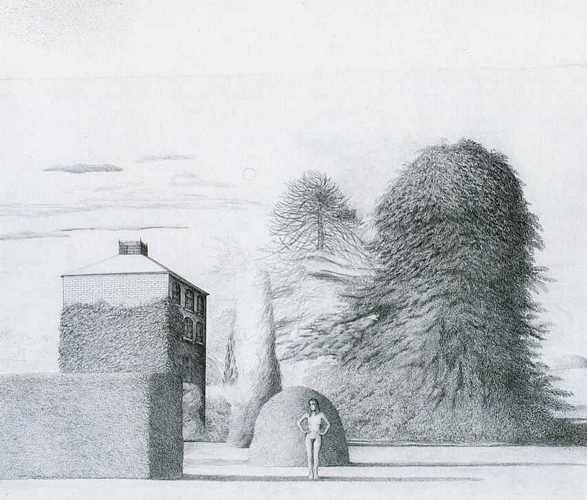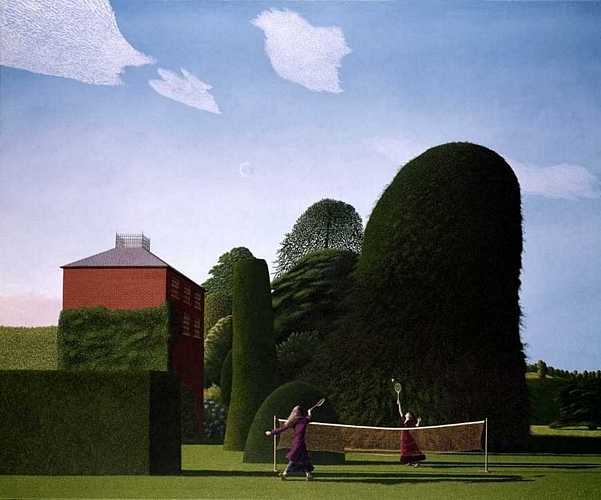4. Badminton replayed
The painting now known as The Badminton Game was originally called Remembering mine the loss is, not the blame, a title taken from the Thomas Hardy poem, She, to Him:
That Sportsman Time but rears his brood to kill,
Knowing me in my soul the very same –
Once who would die to spare you touch of ill –
Will you not grant to old affection's claim
The hand of friendship down Life's sunless hill?
The final idea for the painting came to David Inshaw during a dinner party in Bath after a guest mentioned she had come across an old badminton set in her grandmother's attic. Inshaw had been searching for ways to complete an imaginary garden he had been developing, influenced by the landscape of Wiltshire. The Badminton Game is one of a number of works of this time influenced in particular by houses and gardens in Devizes. The painstakingly detailed Study for The Badminton Game represents the final stages in his perfection of this landscape and the naked figure was included to give an idea of the intended scale.

Inshaw has written of The Badminton Game: 'It was the first picture I made that had a Devizes 'feel' about it, although the elements that go to
make up the picture relate to some things that went on before I moved to Devizes in the autumn of 1971. I had moved to Devizes for a number of reasons, to get away from
Bristol, a place I love, but the art school where I taught seemed to be taking more and more of my time and students were continually calling on Alf [Stockham] and me.
I had got to know the Downs and the Vale of Pewsey by visits to Avebury and Stonehenge, and Marlborough for fish and chips on many evenings. We thought they were the best
in the country.'
'I fell in love with the Downs and the Vale on my first visit. I felt as if history had been condensed to a moment by walking in the landscape about Devizes. The
symbols and evidence of man, distant past all around me, gave me reassurance and confidence to develop the ideas that had just begun in me over the previous two years. I
had made a number of pictures using the garden as a theme. I had also become very interested in the photographic image, and had started to take photographs of my own. I
don't know why gardens; my great-grandfather was a gardener and I feel happy surrounded by trees. Trees inspire me very much, and fill me with wonder.'
'I think my main aim was to produce a picture that held a moment in time, but unlike a photograph, which only records an event. I thought a painting could give a
more universal, deeper meaning to that moment, by composing one instant from a lot of different unrelated moments. I thought, as I only wanted an instant in time, it would
take me a long time to paint this picture, so that everything is very carefully composed.'

'For some time I had thought of painting as a way of bringing order to the chaos I saw about me and felt inside me. The more chaos I felt, the more order I desired
in the pictures I made. I had been living in Devizes for nine months when I began the picture, and had got to know and understand the place a little. I was excited by the
warm red brick of the Georgian houses in the town against the early morning spring skies. I had to be up early to go and teach in Bristol, and usually left Devizes at
7:30, and came back to late evening skies. This, with the trees and gardens I could see from the house, gave the colour scheme for the picture.'
'While I was making the drawings for this picture, I had in mind a favourite picture at the National Gallery in London called The Combat of Love and
Chastity [Gherardo di Giovanni del Fora, circa 1475-1500] which I have loved for many years. It has, to my mind, the quality I was seeking to bring to my
own work. It is the moment held in time, as if you are aware of before and after, as if a film had stopped on a single frame, and you are aware, in that instant, of the
emotion of all time. This is very difficult to explain. It's what I still try to do now, because I think it is everything in painting pictures, and I look for it
always. To isolate in time and space things that would normally disappear under the awful impact of other values. I wanted to pin down a moment, make it go on living, I
wanted to be particular and yet general. I wanted to be excessive and yet modest. I wanted the picture to contain all my feelings and thoughts, happy thoughts as well as
sad, full of waking dreams and erotic fancies. I wanted the painting to be of this world and of the world of daydreams.'
'All the while I was working on this picture, workmen were in the house, and everywhere was very uncomfortable and cold. I worked in one tiny room at the top of the
house three or four days a week, drawing and redrawing the composition for the painting until everything seemed to be in its correct order. Everything in the picture is
taken from near my house in Devizes and rearranged into its right place. I changed everything I used in the picture in order to increase the mystery and wonder I felt all
around me in this magic place.'
'I was very much in love with the two girls, and I tried to paint them beautifully and in strong sunlight, so they would know how much I loved them, as if they were
being blessed by the sun in the clear, early morning air. The sky has patches of mackerel sky which forecast rain and hence foreboding, but it's a very hopeful
picture and only slightly disquieting because I was discovering all about Wiltshire (but not so much about women).'

